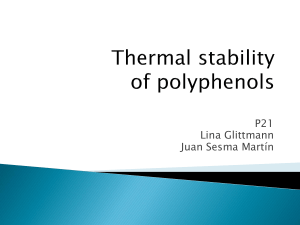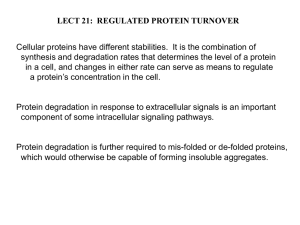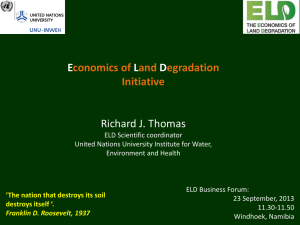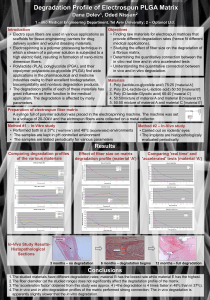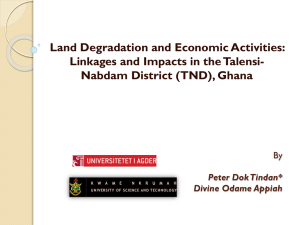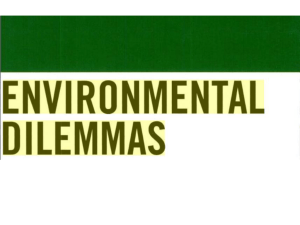Solid State Degradation Mechanisms: Impact on
advertisement
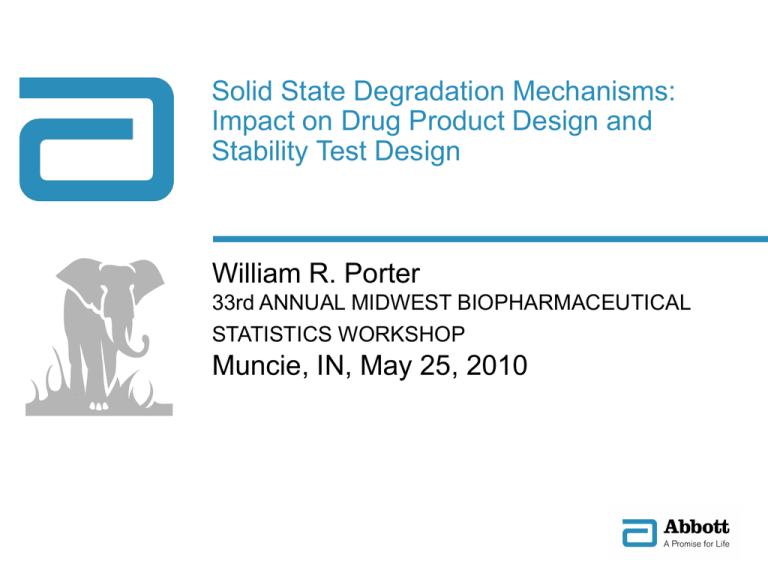
Solid State Degradation Mechanisms: Impact on Drug Product Design and Stability Test Design William R. Porter 33rd ANNUAL MIDWEST BIOPHARMACEUTICAL STATISTICS WORKSHOP Muncie, IN, May 25, 2010 Stability by Design (SbD): Instability Assessment— A Tool for Product Development …in order to design stable products, you must first understand how your product degrades! Solid State Degradation Mechanisms May 25, 2010 © 2010 Abbott 2 Why “instability” assessment? “Good” bulk storage conditions, formulations and packaging are really those that are “least bad.” In order to develop “good” processes and procedures, you must first... Solid State Degradation Mechanisms May 25, 2010 © 2010 Abbott 3 Find an elephant… …to step on your product to make it fail! Elephant tests are… • Designed to induce product failure. • Used to learn how the product fails under a particular stress so that it can be redesigned to avert this particular failure mode. • Useful in early phases of development to select between alternate strategies. References: Nelson W. Accelerated Testing: Statistical Models, Test Plans, and Data Analysis. New York: John Wiley & Sons (1990). Meeker WO, Escobar LA Statistical Methods for Reliability Data, New York: John Wiley & Sons (1998). Solid State Degradation Mechanisms May 25, 2010 © 2010 Abbott 4 What is a good elephant test? One that produces the same failures and in the same proportions that will occur in actual use, but in shorter time. Elephant tests use stress conditions that exceed normal environmental conditions to degrade product performance. Solid State Degradation Mechanisms May 25, 2010 © 2010 Abbott 5 Elephant tests should... Be done as soon as possible during formulation development. Involve the whole team in design and implementation. Use laboratory (NOT production support) facilities (meet good scientific quality standards, not GMP). Use best available methods for analysis. Have adequate controls to minimize method validation requirements . Solid State Degradation Mechanisms May 25, 2010 © 2010 Abbott 6 Prerequisites for instability assessment “Stability-indicating” assay… • “chicken & egg problem” —Need to understand how material degrades to validate assay, need assay to understand how material degrades. Controlled environment storage facilities… • Need controlled temperature, controlled humidity, controlled light stress. – Control does NOT mean constant, but nonisofactorial conditions complicate data analysis Bulk material typical of future production lots… • Atypical bulk material may have atypical failure modes. Planning is the most crucial element of a successful program… …Timing isn’t everything; it’s the only thing! Solid State Degradation Mechanisms May 25, 2010 © 2010 Abbott 7 How do drugs degrade? Reaction with solvent (solvolysis)* • Hydrolysis, when the solvent is water Reaction with oxygen (oxidation)* Reaction with radiant energy (photolysis) Reaction with manufacturing impurities* Arrhenius kinetics (effect of heat on reaction rate) Rate Frequency Activation Factor Energy Ea RT kT Ae Reaction with added excipients* T (Kelvin) = Reaction with degradation products* absolute temperature *Most, if not all of these processes are accelerated by heat! …and the Arrhenius model usually can be applied to any process that is accelerated by heat. Solid State Degradation Mechanisms May 25, 2010 © 2010 Abbott 8 Thermal stress tests for solids Arrhenius assumption often invalid, because… • Phase changes, adsorbed moisture invalidate assumptions True, but “reasonable” stress still practical… That depends… Use lowest temperature that produces measurable failure within allocated time to avoid these complications. • Using higher temperatures to save time can lead to changes in failure mechanism, so always have a Plan B (additional samples stored at a lower temperature for a longer time; assay these if higher temperature samples show excessive degradation). Good news is good news; bad news is no news.* *You need to execute Plan B…and that takes extra time and money! Solid State Degradation Mechanisms May 25, 2010 © 2010 Abbott 9 Chemical Degradation for People Who Forgot Physical Organic Chemistry CH3 O CH3 O H2O O O H O O R-(+)-warfarin HO - H Lactone hydrolysis OH pH control Pseudo-Zero-Order Kinetics O O Pseudo-Zero-Order Arrhenius Plot 120.0 - 2 E a = 80.8 kJ/mol 1 (chromandione tautomer) Decarboxylation 0 100.0 CO2 -1 OH O H3C O - Tautomerization OH OH Concentration O -2 80.0 ln(k) - HC -3 -4 60.0 -5 -6 40.0 -7 Aldol cyclization -8 0.0027 O O 0.0028 0.0029 0.0030 0.0031 20.0 0.0032 H2O ln(k) O 0.0 - 0 1 2 3 + OH H Dehydration pH control 4 5 6 7 8 All three temperatures used Time. days OH 25 °C (5S)-3-(2-hydroxyphenyl)5-phenylcyclohex-2-en-1-one ("Alice's ketone") Solid State Degradation Mechanisms May 25, 2010 0.0033 0.0034 0.0035 0.0036 –1 1/T, K Control 60 °C 75 °C 90 °C © 2010 Abbott 60 °C fit 75 °C fit 90 °C fit 5 °C 10 Temperature 5 °C 25 °C 60 °C 75 °C 90 °C Time for 2% Change in Potency, days From Fitted Rate From Arrhenius Model 3513 337 9 11 3 3 1 1 Only data from three temperatures were used. Some books to read in your copious spare time… If (heaven forbid!) you have never taken a course in organic chemistry… • Winter A. Organic Chemistry 1 for Dummies. John Wiley & Sons (2005). If you have forgotten organic chemistry… • Smith MB, March J. March's Advanced Organic Chemistry : Reactions, Mechanisms, and Structure. John Wiley & Sons (2007). If you have forgotten chemical kinetics and physical chemistry… Moore JW, Pearson RG. Kinetics and Mechanism. John Wiley & Sons (1981). If you want to focus on stress testing of pharmaceuticals… Baertschi SW. Pharmaceutical Stress Testing: Predicting Drug Degradation. Taylor & Francis (2005). Yoshioka S, Stella VJ. Stability of Drugs and Dosage Forms. Kluwer Academic/Plenum Publishers (2000) Carstensen JT. Drug Stability Principles and Practices (2nd Ed). Marcel Dekker (1995) Solid State Degradation Mechanisms May 25, 2010 © 2010 Abbott 11 …not to mention self-promotion… Book chapters I’ve written on the subject: • Zhou D, Porter WR, Zhang GZZ. “Drug Stability and Degradation Studies.” Chapter 5 in: Qiu Y, Chen Y, Zhang GGZ, Liu L, Porter WR. Developing Solid Oral Dosage Forms: Pharmaceutical Theory and Practice. Elsevier/Academic Press (2009). • Porter WR. “Residues and Cleaning Chemistry,” Chapter 9 in Pluta P. Cleaning and Cleaning Validation, Vol 1. PDA/Davis Healthcare International Publishing LLC (2009). Solid State Degradation Mechanisms May 25, 2010 © 2010 Abbott 12 Hydrolysis Hydrolysis is by far the most commonly encountered drug degradation reaction both in solution and in the solid state. Examples: • Carboxylic acid derivatives. O R1 O X + H2O R1 OH + HX • Acetals and ketals. R2C(OR')2 H+ + H2O R2C=O + 2R'OH • Nitrogen derivatives of carbonyl compounds. R2C=NR' Solid State Degradation Mechanisms May 25, 2010 + H2O R2C=O © 2010 Abbott + R'NH2 13 Oxidation Oxidation is a major drug degradation pathway, second only to hydrolysis. Examples: R1 H • Amines HO N N R1 H OH • Sulfur moieties R1 R2 H R2 O O R3 SH R1 R3 S R1 O O O OH HO H R1 S R2 O O R3 R2 - O R2 R1 O R2 + N R2 R1 O O R1 O O N R2 R2 • Alcohols R1 R1 O O R1 R2 O R3 S R1 O O R2 O OH H R1 O O H H Solid State Degradation Mechanisms May 25, 2010 R2 R2 H R1 O © 2010 Abbott H H2O H OH OH R2 14 S O • Alkenes & alkynes R1 R3 OH Photolysis To undergo photodegradation, compound must absorb light in the same spectral region as the radiant energy to which it is exposed. • No absoption no reaction R1 Examples • Radical induced oxidation R1 R2 h H R3 • Radical formation and polymerization O R1 O © 2010 Abbott O R3 OH R2 C R3 R1 R1 R2 C R3 Solid State Degradation Mechanisms May 25, 2010 R2 15 R1 R2 R2 R3 R3 Solid State Chemical Kinetics One score and thirteen years ago, physical chemists brought forth upon this planet a new paradigm, conceived in simplicity, and dedicated to the principle that all solid state kinetics problems can be solved by replacing kinetic models and rates with time-to-failure. Based on: Vyazovkin A & Wight CA. Kinetics in Solids Annu Rev Phys Chem. 48:125-149 (1977) Look at the date! Solid State Degradation Mechanisms May 25, 2010 © 2010 Abbott 16 Chemical Kinetics In solution: In solids: • Traditionally based on kinetic models in which concentration (C) is monitored as a function of time. • Based on models in which fraction degraded (α) is monitored as a function of time. • Reaction order concept dominates model choices. • Reaction order models less common. – In stability experiments, most kinetic models can be replaced by a zero-order model with little loss of accuracy. – Stress experiments are usually run under conditions such that either zero- or first-order kinetic models can be fitted to the data. – Diffusion models – Geometric contraction models – Reaction order models – Induction models • Power law growth… – You see nothing, nothing, nothing, nothing, – then WHAM! you get explosive growth, and your product fails catastrophically. Because your analytical method is too insensitive! Solid State Degradation Mechanisms May 25, 2010 © 2010 Abbott 17 The traditional unreadable slide… Derivative form Integral form From: Vyazovkin A & Wight CA. Kinetics in Solids Annu Rev Phys Chem. 48:127-1128 (1977) Solid State Degradation Mechanisms May 25, 2010 © 2010 Abbott 18 …and another Example is based on a nonisothermal kinetics experiment. From: Vyazovkin A & Wight CA. Kinetics in Solids Annu Rev Phys Chem. 48:132-133 (1977) Their point: You can fit all 13 models to the same set of data, and they all fit equally well… Solid State Degradation Mechanisms May 25, 2010 © 2010 Abbott 19 So, what does this mean? Vyazovkin & Wight demonstrated that isoconversional methods gave consistent results and were model-free. 1 t ,T kT f t g t ,T kT t t ,T ,h E f t ,T ,h A exp Bh a RT E g t ,T ,h A exp Bh a t RT lnkT ,%RH ln A Ea Bh RT E A exp Bh a RT Ken Waterman at Pfizer is popularizing this model … *Effect of temperature and relative humidity on nitrazepam stability in solid state. J Pharm Sci 66: 676–680 (1977) Solid State Degradation Mechanisms May 25, 2010 humidity h: t Genton & Kesselring* proposed this modified Arrhenius model: kT ,%RH Time-course of the reaction at any particular temperature T and relative © 2010 Abbott Vyazovkin and Wight pointed out that the use of the Arrhenius equation in solid state kinetics is supported by a sound theoretical foundation. But experimental difficulties in actually studying solid state reactions make it difficult, if not impossible, to isolate an elementary reaction (e.g., nucleation, crystal growth) whose molecularity can be determined that is uncomplicated by diffusion, adsorption, desorption and other physical processes. 20 All things cometh to they who waiteth… …but isn’t 33 years of waiting a little bit too long? Everything we needed to know to design thermal stress degradation experiments for solids was known in 1977. The key, as pointed out by Vyazovkin & Wight, was to use “model-free” methods. All you need to do is replace rates (which depend on kinetic models) with time-to-failure: t 0.005 ,T g 0.005 E Ag exp Bh a RT The Arrhenius frequency factor A is a function of g, but g itself is independent of the temperature T. Solid State Degradation Mechanisms May 25, 2010 © 2010 Abbott 21 Using time-to-failure data at stress conditions… It’s possible to make measurements at three separate conditions of temperature and relative humidity and then solve the modified Arrhenius equation to calculate the time-to-failure at any other temperature and relative humidity: ln t constant ,Tl ,hl ln t constant ,Th ,hh Ea R 1 1 Th, Tl , constant constant B hh, hl , constant constant A plot of the logarithm of the time ti to obtain a specific fraction degraded α versus the reciprocal absolute temperature Ti and relative humidity hi at which α was determined is a plane in three-dimensional space: ln t constant ,Ti ,hi Ea Bhi C g , constant RTi Parameters estimated by fitting Arrhenius model to time-to-failure data Solid State Degradation Mechanisms May 25, 2010 © 2010 Abbott 22 …we can calculate the shelf-life! ln t constant ,Tnew ,hnew Ea Bhnew C g , constant RTnew Yes, C is kinetic model-dependent, but we can use data from other temperature and relative humidity experiments to eliminate this nuisance parameter. It’s just one of the Arrhenius-humidity model-fitting parameters that is obtained when you fit the Arrhenius-humidity plane to the temperature × relative humidity time-to-failure data. It has no meaning unless, of course, you decide to select a particular kinetic model. Solid State Degradation Mechanisms May 25, 2010 © 2010 Abbott 23 …or, we can calculate how long to expose samples to thermal stress to support a desired shelf-life Time Required to Achieve Constant Fractional Degradation as a Function of Temperature at B×h = 0 for tlow = 2 Years at 25 °C Temperature t(1 – α) (days) for Ea, kJoules/mole T to cut t in half @ Ea = 71.74 kJmol–1 °C K 25 298.15 32 305.15 459.91 392.96 40 313.15 277.99 48 321.15 56 50b 67b 71.74a,b 84b 100b 117b 376.10 335.76 289.55 247.40 200.15 182.63 144.11 105.79 76.17 172.29 105.43 91.93 64.52 40.64 24.87 329.15 109.30 57.29 47.85 30.03 16.35 8.57 65 338.15 67.21 29.86 23.82 13.27 6.18 2.75 75 348.15 40.32 15.06 11.44 5.62 2.23 0.83 85 358.15 24.90 7.89 5.73 2.50 0.85 0.27 730.50 days a. “Rule of thumb” assumed value for ICH accelerated stability extrapolation. b. Note that 50 kJ/mol ≈ 12 kcal/mol, 67 kJ/mol ≈ 16 kcal/mol, 84 kJ/mol ≈ 20 kcal/mol, 100 kJ/mol ≈ 24 kcal/mol, and 117 kJ/mol ≈ 28 kcal/mol. Solid State Degradation Mechanisms May 25, 2010 © 2010 Abbott 24 What temperature and humidity conditions must our products survive? ICH Guideline Q1A(R2) recommends storage conditions of 25 °C at 60% RH and 40 °C at 75% RH as a general case for use in “long term” and “accelerated” stability trials. An “intermediate” storage condition of 30 °C at 65% RH is used to provide backup data in the event that product failure is detected under “accelerated” stress conditions. Can we predict whether or not a drug substance or drug product is likely to meet specifications as recommended in ICH Guidelines Q3A(R2) and Q3B(R2) using the Genton and Kesselring expanded Arrhenius model and data obtained under higher temperature and higher humidity? Solid State Degradation Mechanisms May 25, 2010 © 2010 Abbott 25 The Waterman plan… Ken Waterman and colleagues at Pfizer recently proposed timeto-failure stress degradation studies using a range of accelerated temperature and a range of relative humidity storage conditions to be used routinely for preformulation and early formulation development studies. • Waterman KC, Carella AJ, Gumkowski MJ, Lukulay P, MacDonald BC, Roy MC, Shamblin SL. Improved protocol and data analysis for accelerated shelf-life estimation. Pharm Res 24(4):780–790 (2007). • Waterman K. “Accelerated Stability Assessment Program (ASAP): Using Science to Set Shelf Life,” presented at 5th Annual Forced Degradation Strategies for Small Molecules, Baltimore, MD, February 26, 2008. Solid State Degradation Mechanisms May 25, 2010 © 2010 Abbott 26 Waterman’s “improved” 2008 design… T, °C h,% RH 50 60 60 70 70 80 75 5 40 5 75 40 Sampling Time, days 4, 14 14, 21 4, 21 4, 21 ⅓, 2 ⅓, 4 The time at 70 °C is probably long enough, but at 60 °C it should be doubled… Solid State Degradation Mechanisms May 25, 2010 For moisture-sensitive materials, the low humidity samples will degrade very slowly, so much so that no degradation will be seen in the short exposure times used. Unless the humidity used in the “accelerated” test is greater than or equal to the humidity used in the “real time” test, which under ICH guidance is typically 60% RH at 25 °C, then the “accelerated” test will actually take much longer than the “real time” test to produce the same fractional degradation! © 2010 Abbott 27 How does B (sensitivity to humidity) affect time-to failure at different temperatures for different Ea? Time Required to Achieve Constant Fractional Degradation as a Function of Temperature at 75% Relative Humidity B= 0.01 0.01 0.01 0.01 0.03 0.03 0.03 0.03 0.05 0.05 0.05 0.05 0.07 0.07 0.07 0.07 0.09 0.09 0.09 0.09 Temperature T, °C T, K 25 298.15 40 313.15 50 323.15 60 333.15 75 348.15 40 313.15 50 323.15 60 333.15 75 348.15 40 313.15 50 323.15 60 333.15 75 348.15 40 313.15 50 323.15 60 333.15 75 348.15 40 313.15 50 323.15 60 333.15 75 348.15 Solid State Degradation Mechanisms May 25, 2010 50 67 239.26 132.07 75.54 34.71 177.25 97.84 55.96 25.71 131.31 72.48 41.46 19.05 97.28 53.69 30.71 14.11 72.07 39.78 22.75 10.45 Ea, kJ/mole 84 730.50 days 172.27 124.04 77.69 45.70 36.75 17.88 12.96 4.84 127.62 91.89 57.56 33.86 27.23 13.25 9.60 3.59 94.55 68.07 42.64 25.08 20.17 9.81 7.11 2.66 70.04 50.43 31.59 18.58 14.94 7.27 5.27 1.97 51.89 37.36 23.40 13.77 11.07 5.39 3.90 1.46 © 2010 Abbott 100 117 91.05 27.74 9.08 1.92 67.45 20.55 6.72 1.42 49.97 15.22 4.98 1.05 37.02 11.28 3.69 0.78 27.42 8.36 2.73 0.58 28 65.56 16.32 4.42 0.72 48.57 12.09 3.27 0.53 35.98 8.96 2.42 0.39 26.65 6.63 1.80 0.29 19.75 4.92 1.33 0.22 h= %RH 60 75 75 75 75 75 75 75 75 75 75 75 75 75 75 75 75 75 75 75 75 What is the effect of humidity h… …for different moisture sensitivities (B)? Storage Time in Days Required to Achieve Degradation Equivalent to Storage for 2 Years at 25 °C, 60% RH 0.09 Ea kJ/mole 50 T °C 50 T h = 10% h = 30% h = 50% h = 75% h = 80% h = 5% RH K RH RH RH RH RH 323.15 21661.58 13812.03 2283.11 377.40 39.78 25.36 0.09 50 60 333.15 12390.63 7900.62 1305.96 215.87 22.75 14.51 0.09 50 65 338.15 9488.03 6049.83 1000.03 165.30 17.42 11.11 0.09 50 75 348.15 5692.84 3629.92 600.02 99.18 10.45 6.67 0.05 84 50 323.15 830.64 646.91 237.98 87.55 25.08 19.53 0.05 84 60 333.15 324.98 253.09 93.11 34.25 9.81 7.64 0.05 84 65 338.15 207.54 161.64 59.46 21.88 6.27 4.88 0.05 84 75 348.15 87.98 68.52 25.21 9.27 2.66 2.07 0.01 117 50 323.15 32.86 31.26 25.59 20.95 16.32 15.52 0.01 117 60 333.15 8.89 8.46 6.93 5.67 4.42 4.20 0.01 117 65 338.15 4.76 4.53 3.71 3.04 2.36 2.25 0.01 117 75 348.15 1.44 1.37 1.12 0.92 0.72 0.68 B Solid State Degradation Mechanisms May 25, 2010 © 2010 Abbott 29 So, what does this mean? When substances sensitive to moisture (large B) are subjected to thermal stress under conditions of low humidity (small h), it can take a very long time for substances having a low Arrhenius activation energy (small Ea) to degrade, even at elevated temperatures (high T) to the same extent that would be observed in a real time stability trial conducted in accordance with ICH Guidelines. • For example, in the case where B = 0.09, h = 5% RH, Ea = 50 kJ/mole and T = 75 °C, it would take 5693 days exposure to achieve the same amount of degradation seen in 730 days at 25 °C and 60% RH Conclusion: Experiments at low humidity are useless for moisture sensitive compounds. Solid State Degradation Mechanisms May 25, 2010 © 2010 Abbott 30 A better design… Skip the low humidity test conditions • You really need to do initial experiments at only one humidity—the highest the product must ever face. • Per ICH guidelines, this is 75% RH for all climate zones. Use the highest thermal stress that does not result in a change of physical form. • Desolvation/dehydration • Polymorph conversion If you have time, use two or more temperatures to estimate Ea. Solid State Degradation Mechanisms May 25, 2010 © 2010 Abbott 31 But what about those thirteen kinetic models? When only a small amount of degradation occurs, these can be approximated by only FIVE kinetic models: • Diffusion model (time-to-failure tα ≈ C×square root of time) • Zero-order model (time-to-failure tα ≈ C×time) • Power law models (time-to-failure tα ≈ C×timen, n = 2,3,4) You only need a few different sampling times to establish the shape of the curve. Solid State Degradation Mechanisms May 25, 2010 © 2010 Abbott 32 Hypothetical Stability Trial Results Stability Trial Assay Results Need to know shape of plot in advance! 0.55% Threshold for toxicological qualification 0.50% – not detected… – or not quantifiable, …so you need to modify the stability sampling plan. Solid State Degradation Mechanisms May 25, 2010 0.45% Critical Degradant, % • Use data from high temperature and high humidity degradation experiment. • Note that for power law (induction) kinetics, early degradation is either: 0.40% 0.35% 0.30% 0.25% 0.20% 0.15% 0.10% Detected, Not Quantified 0.05% Not Detected 0.00% 0 0.5 1 1.5 2 Time, Years Diffusion © 2010 Abbott Zero Order Quadratic 33 Cubic Quartic
